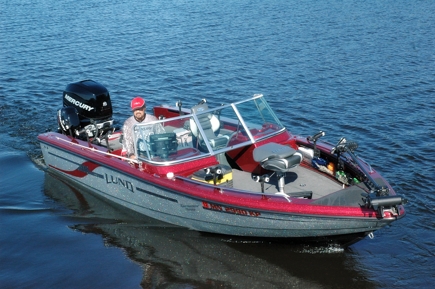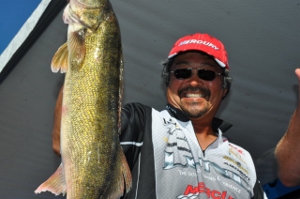3-D Walleyes
Dec 5th, 2011 by OutdoorsFIRST
Modified Dec 5th, 2011 at 12:00 AM
 |
|
|
Rigging your boat with useful electronics gives you the tools it takes to ‘see’ how the bottom of the lake lays out!
|
It would be easy for anglers to fall victim to the notion that the watery world below is two-dimensional. The water’s surface is flat. Lake and river maps are flat. Your sonar screen is flat. But down below, the bottom consists of peaks and valleys just like the dry world above.
Changes in bottom contours are called structure and understanding how structure affects fish behavior is the key to angling success. The trick is to train our minds to translate two-dimensional images from a map, your sonar screen, or GPS into mental images with three dimensions. A technique called visualization can help you with this task.
Many professional athletes have used visualization within their respective sports. When Tiger Woods lines up a putt, he “sees” himself stroking the ball, follow the breaks, and watches it roll into the cup. When Michael Jordan played basketball, he saw himself hitting nothing but net time after time. Fishermen can practice the same method by taking information from the tools they have to visualize every subtle break and fish-holding feature below the boat.
The importance of this skill cannot be stressed too much in the case of walleyes. Walleyes that relate to structure are catchable fish. With the exception of spring spawn, they are there most of the year for just one reason – to eat. Walleyes which are suspended in open water are often there one day and gone the next. On the other hand, walleyes lurking on a point or hump will take up residence as long as food is handy and weather is stable.
 |
|
|
Ted With an FLW Competition Walleye (OFM Photo)
|
Fish utilize the breaklines on structure as migration paths and will often congregate where the breakline makes slight changes along the way. This is the 10 percent of the water which often holds 90 percent of the fish. Your challenge is to understand where those contact points are and how to fish them.
But how many of us take the time to analyze our favorite fishing holes in order to understand why they produce time and time again? Think of one of your best spots. How is it shaped? Where are the points, the sub-points off the main point, and the inside turns? Some of these are known as the “spot-on-a-spot” and each one may hold fish.
What is the bottom composed of? Is the grey line on the bottom of your sonar screen thick, which indicates hard bottom, or thin which means a soft bottom? Transition areas from hard to soft can offer a variety of food for fish to eat, so they stay. Same is true for other changes on the bottom, such as places were pea gravel meets larger rocks.
Where are other features? Are there weeds? How is the weedline shaped? The weedline’s points and turns are important fish locators for the same reason structural points and turns are. They hold fish. Where do weeds change from one kind to another? This often signals a subtle change in the bottom content.
Practice “seeing” every detail in your mind. Just like having x-ray vision, you should eventually be able to use your tools to look down and “see” the structure. Once you can visualize them, fish the “something different” – the hard to soft bottom areas, the turns, the points, the weed patches, or the rock piles. Each one may prove to be a fish magnet.
One of the most important tools of structure fishermen is a contour map. A map and an understanding of seasonal movements can eliminate unproductive water fast. The closer the contour lines, the sharper the break is. Weedlines or mid lake humps are productive during the summer, but deep and sharper structure breaks are good in the in fall. Be aware of changes in wind direction which will push plankton and pursuing baitfish to one side of the lake or the other.
The need for good electronics, like a Humminbird 1198c, is critical to the process. Once on the water, use your sonar and GPS to of a point or hump. In the case of mid-lake humps, try motoring over and around it to locate the top. Toss out marker buoys at critical spots to help visualize what lies below.
Using a jig or the weight on a live-bait rig, whether a bottom bouncer or a Lindy sinker, are also great tools to learn more about what lies below.
Start fishing with quick presentations to cover water and find aggressive fish. Nothing? Go progressively slower. Use your bow-mounted trolling motor to move along the break from shallow, down the edge to the base and back up again. Keep a 45-degree angle between your line and water’s surface. Pay attention to what your jig or rig is telling you about the bottom content. They will telegraph details like the position of small gravel or rocks on a soft bottom, where weedlines starts, etc. If unsure about what you sense through the rod, an underwater cameras can confirm what you are fishing.
Note the depth and particular kind of structural element when you begin to contact fish. Use the map to find similar spots. The goal is to discover a productive pattern including structure type, depth and presentation.
Don’t fish blind. Practice visualizing structure, and see your success soar.